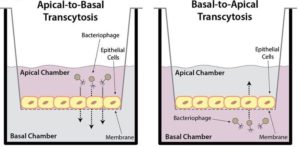 The TWiV ninjas reveal that bacteriophage particles rapidly move across monolayers of eukaryotic cells from different tissues.
The TWiV ninjas reveal that bacteriophage particles rapidly move across monolayers of eukaryotic cells from different tissues.
Hosts: Vincent Racaniello, Dickson Despommier, Alan Dove, Rich Condit, and Kathy Spindler
Click arrow to play
Download TWiV 470 (71 MB .mp3, 117 min)
Subscribe (free): iTunes, RSS, email
Become a patron of TWiV!
Links for this episode
- Transcytosis of bacteriophage across cell layers (mBio)
- Image credit
- Letters read on TWiV 470
This episode is brought to you by Blue Apron. Blue Apron is the #1 fresh ingredient and recipe delivery service in the country. Get $30 off your first delivery and FREE SHIPPING by going to blueapron.com/twiv.
Weekly Science Picks
Kathy – Photo of 3200 year-old tree in one image
Dickson – Microsculpture
Rich – A Short History Of Humans And Germs
Alan – Planets app
Vincent – Laptops Are Great. But Not During a Lecture or a Meeting
Listener Picks
Basel – Joint Pathology Center
John – OpenStax
Intro music is by Ronald Jenkees.
Send your virology questions and comments to [email protected]


Hi there, I heard your questions about the CLEM (Correlative Light Electron Microscopy) experiment from the transcytosis paper and wanted to clear up a few things:
1) I acquired the optical and electron images a week apart using 2 different microscopes: a Leica SP8 laser scanning confocal and a Hitachi H7500 Transmission Electron Microscope.
2) I used a modified version of my previously published protocol (DOI: 10.1371/journal.pone.0095967)
3) Kathy had it right: The sub-cellular locations were relocated after ultrathin sectioning of the resin embedded sample.
4) When I started the experiment, I was really surprised by how many phages there were inside the cells… yet none of them seemed to correlate directly with the optical data. That’s when we realised that SYBR was pH sensitive. This is a problem, because endosomes are slightly acidic (~pH6 for early endosomes; ~pH5 for late endosomes). The phages were leaking SYBR almost immediately after entering the cells. Hindsight is a cruel mistress; should have used a pH resistant dye.